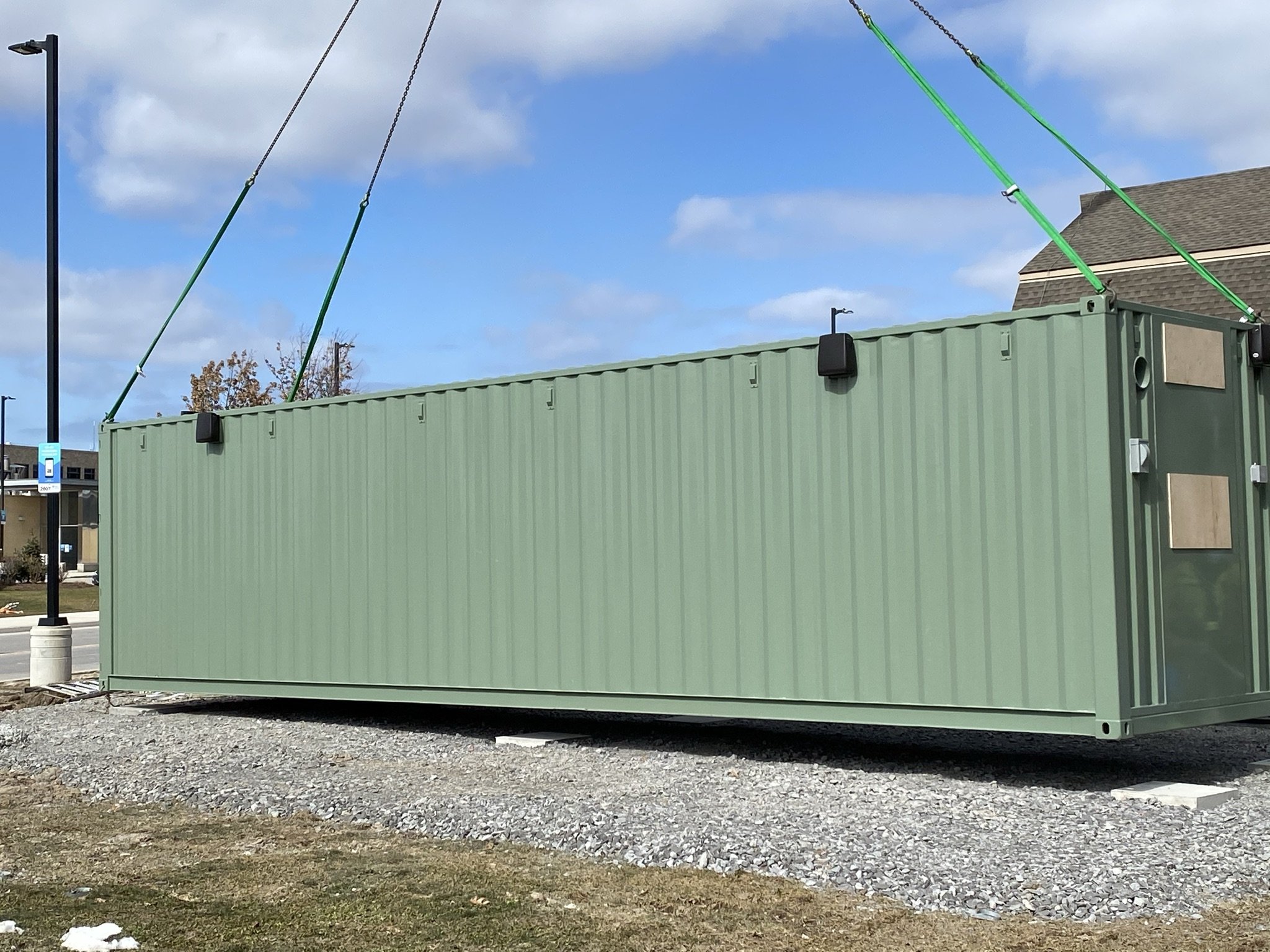Niagara College Opens CannaResearchBunker Lab Facility
Photo of the CannaResearchBunker as it was first being installed on the Niagara College's Daniel J. Patterson Campus in Niagara-on-the-Lake, Ontario.
BILL MACDONALD
Niagara College is home to Canada’s first commercial cannabis production program, which was launched in 2018. The school has expanded its on-campus cannabis education program with the addition of a Cannabis Production Research Chamber at its Daniel J. Patterson Campus in Niagara-on-the-Lake, close to the US border near Buffalo, NY. The new research facility, dubbed the “CannaResearchBunker,” is made from two retrofitted sea containers connected to the original “CannaBunker” facility. The 320 sq. ft. lab houses specialized equipment to needed to grow crops, as well as to conduct trials and research in partnership with the cannabis industry. The expansion is part of the Niagara College Agriculture & Environmental Technologies Innovation Centre (AETIC), a center within the college’s Research & Innovation division. Funding for the unit was provided by the Natural Sciences and Engineering Research Council of Canada (NSERC) through their College and Community Innovation Program’s Applied Research Tools and Instruments (ARTI) Grant.
The project design and construction was mainly an in-house effort, with assistance from Quartek as architects and mechanical and electrical engineers, and construction services from Stolk Construction Ltd. The unit was delivered and in place as of March 2021, and the task of getting everything hooked up and functional will soon be complete. The team behind the lab will then apply for an amendment with Health Canada to include the new bunker under its existing cannabis licence. Intake for new research projects is anticipated to begin in the fall of 2021.
Lab Design News recently spoke to Bill MacDonald, faculty, School of Environmental & Horticultural Studies, and Kimberley Cathline, Research Project Manager, Agriculture & Environmental Technologies Innovation Centre, about the CannaResearchBunker.
Q: What was the need for this facility? Is it replacing an outdated existing facility or accommodating new research/ a new program?
A: We are very excited about our new CannaResearchBunker, which allows the College to expand our activities in cannabis applied research. The facility is part of Niagara College’s Agriculture & Environmental Technologies Innovation Centre (AETIC), a division of Research & Innovation. Funding for the unit was provided by the Natural Sciences and Engineering Research Council of Canada (NSERC) through their College and Community Innovation Program’s Applied Research Tools and Instruments (ARTI) Grant.
Niagara College began its Commercial Cannabis Production (Ontario College Graduate Certificate) program in September 2018. We currently have a secure and isolated CannaBunker to support the program, and this new CannaResearchBunker provides us with a separate space to preform research. The new facility is controlled, sterile, and isolated in order to perform safe, secure, and dependable research projects.
Q: What kinds of sustainability initiatives have been included in the design plan?
A: All water and nutrients are recirculated. Low energy input LED lights have been installed.
Q: Is there anything particularly unique or groundbreaking about your facility or the design plan?
A: Cannabis has been grown in Canada on a limited scale for a number of years for medicinal purposes, and in 2018, Canada legalized recreational cannabis. This means that cannabis has only been grown widely as an agricultural crop in recent years in Canada. As such, there is a lack of research surrounding most aspects of growing the crop, which is a disadvantage for growers. The cannabis industry requires research supports to allow the industry to grow high quality, reliable, and safe cultivars using the most suitable cultural practices and tools. In addition, the limited range of pest control products that are allowed to be used with the crop means that innovative integrated pest management (IPM) strategies and biocontrols need to be investigated and tested.
Areas of applied research for the College using the new facility will include growing methods, production technologies, crop management, support products, crop inputs, pest and disease management, sensors, and a combination of those elements.
There is an ongoing request in the cannabis industry for applied research support, and this new facility will allow AETIC to meet a significant demand. The research will also involve students in the Commercial Cannabis Program and will provide them with real-world experiential learning opportunities. Overall, there is excitement to begin working with our team of research experts to meet the needs and address challenges of industry partners.
Q: What sorts of challenges did you encounter during the design/build process, and how did you overcome them?
A: This was a traditional design-bid-build project. The biggest challenges were delays due to COVID-19 and having the containers fitted up off-site without the opportunity to check on the work being done (due to COVID restrictions). Overall, the process went quite well as we had already been through a similar process with our original Academic CannaBunker.
Q: If a similar facility or program were to look at your lab for inspiration, what do you think they will take away as an example of what they should also implement in their own lab?
A: Health Canada demands very strict protocols (standard operating procedures, or SOPs) in relation to production of cannabis, especially in relation to microbial contamination. Thus, when designing a facility, having easy to clean surfaces is essential. It comes down to the minor details—so, sweat the small stuff.


